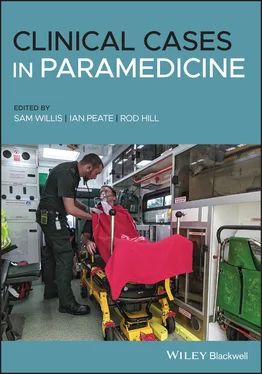Flushed cheeks.
Breathing appears rapid and shallow. An audible wheeze is noted.
SYSTEMATIC APPROACH
Danger
None at this time.
Alert on the AVPU scale.
Clear.
RR: 28. Regular and shallow. No accessory muscle use. Expiratory wheeze on auscultation.
HR: 100. Regular and strong. Capillary refill time <2 seconds. Flushed cheeks and peripherally warm.
Moving all four limbs.
Pupils equal and reactive to light (PEARL).
Bystanders have left. Next of kin are now on scene.
Temperature: warm summer evening – approx. 20 °C.
RR: 28 bpm
HR: 100 bpm
BP: 125/74 mmHg
SpO 2: 93%
Blood glucose: 5.2 mmol/L
Temperature: 36.9 °C
PEF: 300 L/min
GCS: 15/15
4 Lead ECG: sinus tachycardia
Look through the information provided in this case study and highlight all of the information that might concern you as a paramedic.
Aside from auscultation, which you have already done, what examination techniques should you incorporate into this patient assessment? Inspection – observe the chest for an abnormalities such as wounds, scars, bruising, asymmetry and recession.Palpation – feel for any asymmetry, vocal fremitus and tenderness.Percussion – hyper‐ or hypo‐resonance.
What adventitious (added) sounds might indicate asthma and why? Expiratory wheeze. This sound is made when air has a restricted path through the bronchi, due to inflammation and muscle spasm in the airways.
What medicine (pharmacology) is likely to relieve the patient’s symptoms and why? Nebulised salbutamol – it is a Beta2, adrenergic agonist that relaxes smooth muscle in the bronchi.
You treat the patient with 5 mg of nebulised salbutamol and 6 L of oxygen. The nebuliser finishes and you remove the mask.
Patient assessment triangle
General appearance
The patient is now speaking in full sentences.
Flushed.
Normal effort of breathing.
SYSTEMATIC APPROACH
Danger
None at this time.
Alert.
Clear.
RR:16. Regular. Normal depth. No accessory muscle use. No wheeze or adventitious sounds.
HR: 105. Regular and strong. Capillary refill time <2 seconds. Flushed cheeks and peripherally warm.
No change.
No change.
RR: 16 bpm
HR: 105 bpm
BP: 128/78 mmHg
SpO 2: 97%
Blood glucose: not repeated
Temperature: not repeated
PEF: 380 L/min
GCS: 15/15
4 lead ECG: sinus tachycardia
1 What kinds of questions would you ask this patient specifically related to asthma as part of the history‐taking process? See Table 1.1.
Table 1.1 History‐taking questions
| Asthma historyDoes this feel like your normal asthma? Is this the worst it’s ever been? What time did this episode start today? Do you take your asthma medication regularly? What were you doing when it started today? What usually triggers your symptoms? When was the last time your visited your GP and/or went to hospital with these symptoms? Have you ever been intubated or been in ICU with these symptoms? Medication historyWhat asthma medications do you take? How frequently do you have to take your medication? Do you usually have to take your inhaler while exercising? When was the last time you had a medication review with your GP? Have you had any recent changes in medication? Do you take any other medications? Have you had any coaching on the best way to take your inhaler? F/SH (family and social history)Does anyone else in your family experience asthma? Do you smoke? If so, how frequently? Do you drink or take any drugs recreationally? Who do you live with? What do you do for work? Do you exercise regularly? Are you under any particular stress at the moment? Past medical history (PMH)Do you have any other medical problems? Do you have any allergies? Have you had a cough or cold recently? |
1 The patient is 160 cm tall, what should her predicted peak expiratory flow reading (PEFR) be? Her first reading was 300 – what percentage is that from predicted? (Hint: you will be required to look this up using the Australian National Asthma Council chart found here: http://www.peakflow.com/pefr_normal_values.pdfor by doing an internet search.)400 L/min.75%.
LEVEL 1 CASE STUDY
Chronic obstructive pulmonary disease (COPD)
| Information type |
Data |
| Time of origin |
07:09 |
| Time of dispatch |
07:12 |
| On‐scene time |
07:30 |
| Day of the week |
Wednesday |
| Nearest hospital |
15 minutes |
| Nearest backup |
40 minutes |
| Patient details |
Name: Dave Beater DOB: 21/09/1954 |
You have been called to a residential address for a 66‐year‐old male with difficulty in breathing. The caller states he has been breathless all night and has had a cough recently. He has seen his GP who prescribed antibiotics and steroids but he feels his breathing has got worse overnight.
The patient is conscious and breathing and is in a first‐floor flat/unit.
The location appears safe. Greeted at the main door by the patient’s wife.
Wife escorts you up in the lift to the patient’s flat.
On arrival with the patient
Patient is sat in the tripod position and appears distressed. He makes eye contact when you arrive, but does not speak as is so short of breath. He has a productive cough that results in a string of green‐looking sputum that he manages to capture in his handkerchief to show you.
Patient assessment triangle
General appearance
Alert, and makes eye contact, but is acutely distressed. Can only speak in single words and is reluctant to talk. In tripod position, coughing.
Pink face, breathing through pursed lips.
Increased work of breathing – rapid and shallow breaths with accessory muscle use.
SYSTEMATIC APPROACH
Danger
None at this time.
Alert.
Clear.
RR: 36. Rapid and shallow, with accessory muscle use. Widespread bilateral wheeze noted on auscultation.
HR: 110. Radial palpable – irregular. Capillary refill time 2 seconds.
Читать дальше












